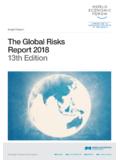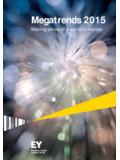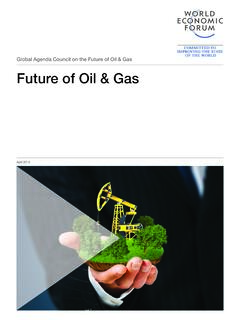Transcription of Global Trends in Renewable Energy - KPMG | US
1 Global Trends in Renewable EnergyIn the last decade, there has been a major uptake in various forms of Renewable Energy , beyond the proof of concept stage, to mainstream use as a commercial alternative to fossil-fuel based Energy generation. 1 UNEP, Bloomberg New Energy Finance2 Refer footnote 13 Renewable 2016 Global Status Report by the Renewable Energy Policy Network for the 21st Century (REN21)4 Refer footnote 35 Refer footnote 1 During this period:147over 2015 while heat capacity additions wereGlobally, the new Renewable Energy power capacity additions weregigawatts (GW)38gigawatts-thermal (GWth) % Renewable Energy provided an estimatedof Global electricity consumption4 Levelised cost of electricity (LCOE)5 dropped across sectors, stimulating a larger number and bigger scale of % increaseBetween 2004 and 2015.
2 With a higher share for developing countriesNew investments in Renewable Energy with119 %Total transaction value related to Renewable Energy assets grew by2 Over the last decade, projects delivering Energy from Renewable sources have become credible low-carbon alternatives to carbon-intensive fossil fuel-based commitment on climate change mitigation under the Paris Agreement in 2015 also helped reduce the short-term impact of low oil prices by acknowledging the longer-term benefits of renewables. The Paris Agreement has already obtained the instruments of ratification, acceptance, approval or accession from more than 55 countries who are cumulatively responsible for 55% of the Global greenhouse gas (GHG) emissions. This is expected to act as a catalyst for Renewable Energy 2015, the UN General Assembly adopted the Sustainable Development Goals on Sustainable Energy for All (SDG 7) initiative.
3 Around the same time, the G7 and G20 groups of countries committed to accelerate programmes on Renewable Energy and Energy efficiency, was some development in the Renewable Energy policy landscape6 too especially for electricity, heating and cooling, transportation, and city and local government initiatives. Many countries now clearly understand the benefits of using Renewable Energy as a source of meeting off-grid and distributed number of countries with Renewable Energy targets and policies increased since 2014, and several jurisdictions made their existing targets more ambitious including a rising number that set their Renewable Energy /electricity targets at 100%. More than 170 countries have Renewable Energy targets, and an estimated 150 countries have policies that support Renewable some impact from a prolonged spell of historically low oil prices, there has been a shift in the Renewable Energy profile in many countries where Renewable Energy resources exist.
4 This was possible through a combination of interventions:use of legislation and feed-in-tariff (FiT) where availabletax incentives on technology imports and developmentadvancement in commercial-scale technologynewer forms of commercial structuring and funding avenues, such as green bond financing6 Refer footnote 37 Refer footnote 33 Global Trends in Renewable EnergyThe last ten years also saw a dramatic drop in the prices of Renewable Energy projects as experience and scale increased. In a 200MW solar photo-voltaic power project, where KPMG8 member firms acted as procurement advisor to the Dubai Electricity and Water Authority (DEWA), the tariff achieved was US$ per kilowatt-hour (kWh), which dropped even further in the following phase of the project of 800MW, currently under a decade of watershed transformation in fossil-fuel dominated Energy generation and the data available (Figure9 below), we can reliably predict the future growth expect to see increase in developing countries, where a sizeable proportion of the population do not have access to electricity10.
5 In many developing countries, Energy sources such as wind, solar and biomass can support decentralized, mini-grid and off-grid solutions, such as, small wind turbines for powering remote telecommunications, solar-powered irrigation kits and rural scale bio-digesters. In developed countries like Australia, Europe, Japan and North America, we have seen significant growth in prosumers residential customers who produce their own electricity through solar Refer footnote 310 Taxes and incentives for Renewable Energy by KPMG International (refer )785276262800700600500400300200010 0 GigawattsWorld TotalBRICSEU-28 ChinaGermanyUnited StatesJapanItalyIndiaSpain20015050010 0 Gigawatts1991229243363332 Ocean powerCSPS olar PVWind powerGeothermal powerBio-powerThe five BRICS countries are Brazil, the Russian Federation, India, China and South 1: Renewable Power Capacities in World, EU 28, BRICS and Top 7 Countries, End-2015 Source.
6 Renewable 2016 Global Status Report by REN21 Based on a mix of policy interventions to limit the funding on fossil-fuel (primarily coal) based generation, easier access to funding for Renewable Energy projects, and technology improvements that reduce project development and operational cost project developers have accessed several sources of funding. New investments in Renewable Energy grew by 18% (in CAGR terms) between 2004 and 2015, to US$ with a higher share for developing During the same period, the total transaction value related to Renewable Energy assets grew by 19% to US$ million. New sources of investment are increasingly available from sources such as the Green Climate Fund and Asian Infrastructure Investment Bank.
7 The Asian Development Bank has also launched several programmes to support Renewable Energy deployment in Asia including framework development initiatives and funding programmes for project development. 11 Global Trends in Renewable Energy Investment 2016 by the United Nations Environment Programme (UNEP)Source: Roadmap for a Renewable Energy Future, 2016 Edition by the International Renewable Energy Agency (IRENA)Figure 2: Renewable Energy use in 2030 with REmap Options, including Modern Energy Access with RenewablesBiofuel powerBiogas powerLiquid biofuel (transport)10%5%1%Traditional uses of bioenergyGeothermal heatSolar thermalRenewable district heat9%5%3%1%Geothermal powerOtherBiofuel (industry)Biofuel (buildings)13%1%1%16%Heat, and other direct uses46%Power44%10%TransportHydropowerCSP S olar PVWind17%1%7%13%REmap - 116 EJ5 Global Trends in Renewable EnergyAs a result, the affordability, cost of electricity to grid off-takers and availability improved significantly.
8 Data available shows that the LCOE for Renewable Energy projects by sub-sectors reduced across the board. (Figure 4)Riding on the success of developing Renewable Energy projects, newer and more innovative technologies are looking to address the need for higher efficiencies, and generation and supply balance between peak and off-peak demands through Energy storage and hybrid generation systems. Intra-day variability is an inherent characteristic in Renewable Energy portfolios, such as in solar PV and wind sources, thereby increasing focus on commercialisation of Energy storage technologies to enhance affordability. Effective storage will assist with creating a buffer to balance grid frequency fluctuation as well as supply during times when the resource is not available ( , solar PV at night).
9 One advantage of biomass power and base load hydropower is the ability to manage the load factor and some countries, such as the Philippines and Thailand have used this successfully to balance their Renewable power mix. Newer project financing mechanisms are also gaining traction. One such example is debt financing using the proceeds from Green Bonds. This form of fund raising by banks (private, national and multi-lateral) and corporations has been particularly useful in mobilising significant volumes solely to fund green (environmentally beneficial) projects. As per the Climate Bond Initiative, the total green bond issuance so far in 2016 has been more than US$50 host of international private equity firms are active in the region and have set up dedicated green Energy funds, including Asia Green Capital Partners, Equis, Infravest, Black Rock, MacQuarie Energy and Olympus Capital Asia to name a few.
10 This has helped to develop a very healthy ecosystem of greenfield as well as secondary markets in the green Energy space in 4: Summary of Lowest Global LCOE Achieved1212 Refer footnote 3 Renewable Energy Sub-sectorGeographyLCOE (US$/kwh) Weighted AverageOn-shore WindChina, Photo-voltaic (PV) Solar-Thermal Power (CSP) , 3: Global Investment Trends in Renewable Energy (in USD billions)Source: UNEP, Bloomberg New Energy FinanceNew investment volume adjusts for re-invested equity. Total values include estimates for undisclosed deals. Developed volumes are based on OECD countries excluding Mexico, Chile and 4375383108123164191151136142130920294660 6475871069813115620042005200620072008200 920102 0112012201320142015 DevelopingUndevelopedBy virtue of new financial options available, in addition to power project developers, there is new interest among cities and municipalities to include Renewable Energy targets in their building private sector is also looking at Renewable Energy options for operations that are heavy consumers of electricity, such as data centres.



















